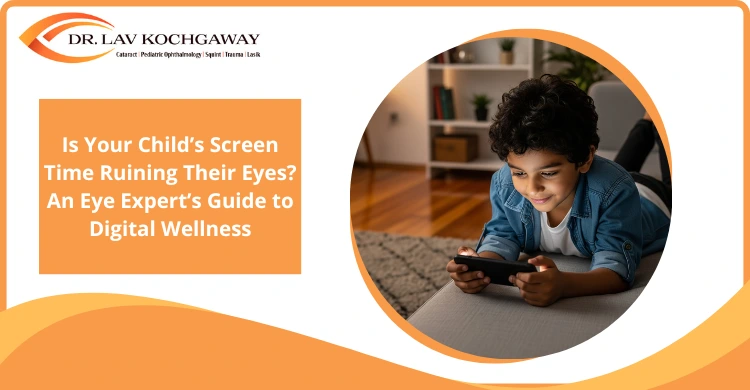
Have you noticed your child holding their tablet too close, rubbing their eyes after gaming, or complaining of headaches after online classes? These subtle signs may point to screen-related vision problems. With devices now an everyday part of childhood, protecting young eyes has never been more important.
Get practical, expert-recommended strategies from a pediatric ophthalmologist to reduce digital eye strain and protect your child’s developing vision.
When it comes to children and screen time, the consequences are more than just “tired eyes.” Let’s break down how excessive screen exposure impacts their eye health:
One of the most common issues associated with screen time is digital eye strain, also known as Computer Vision Syndrome. This condition results from focusing on a screen for prolonged periods, leading to discomfort and fatigue. Children may complain of blurry vision, dry eyes, or headaches after using digital devices for a long time.
Research has shown that too much screen time can increase the risk of developing myopia (nearsightedness) in children. The constant focusing on screens at close distances may alter the shape of the eye, which could lead to difficulty seeing objects at a distance. This condition has become more prevalent as children engage more with digital devices.
Screens emit blue light, a high-energy visible light that can disrupt sleep cycles. Exposure to blue light, particularly in the evening, can suppress the production of melatonin—the hormone responsible for sleep. This disruption may lead to trouble falling asleep, which can affect overall health and well-being.
Staring at a screen often leads to reduced blinking, causing the eyes to dry out. The lack of frequent blinking, combined with the strain of focusing on the screen, can lead to eye fatigue and discomfort. In children, this can be especially problematic as their visual systems are still developing.
It’s essential to keep an eye out for physical and behavioral cues that may indicate your child is experiencing eye strain. Some common symptoms include:
If your child is exhibiting any of these signs, it might be time to re-evaluate their screen habits and consult with an eye specialist.
Children’s eyes are particularly susceptible to the effects of screen time for a few reasons:
According to the American Academy of Pediatrics (AAP), screen time should be limited based on age. For children aged 2 to 5, the AAP recommends no more than one hour of screen time per day. For older children, the key is to establish healthy boundaries, including:
To protect your child’s eyes from digital strain, here are a few expert-recommended strategies:
Every 20 minutes, have your child look at something 20 feet away for at least 20 seconds. This simple practice helps reduce digital eye strain and encourages regular breaks.
Ensure that your child’s screen is at eye level and about an arm’s length away. Also, use proper lighting to reduce glare and improve visibility.
Many devices offer blue light filters or night mode settings. These features can help reduce the impact of blue light exposure, particularly in the evening.
Encourage your child to blink frequently and maintain good posture while using digital devices. Consider setting a timer to remind them to take breaks and adjust their position regularly.
Spending time outdoors helps reduce the risk of myopia by allowing the eyes to focus on objects at varying distances. Encourage your child to play outside for at least one to two hours each day.
If your child is experiencing persistent eye discomfort or exhibiting signs of digital eye strain, it’s important to schedule an eye exam with a pediatric ophthalmologist. Regular eye checkups are essential for detecting and addressing potential issues early on.
During a pediatric eye exam, the specialist will assess your child’s vision, screen for common eye problems, and provide guidance on how to maintain optimal eye health.
Your child’s eyes are still developing, and even small amounts of strain can lead to bigger vision problems over time. If you notice signs like eye rubbing, squinting, or headaches after screen use, don’t ignore them. Take proactive steps to manage screen habits and protect their eyesight.
Safeguard your child’s vision before minor discomfort turns into lasting damage. Dr. Lav Kochgaway provides expert, personalized care to keep young eyes healthy, strong, and ready for the future.
Book your child’s eye exam today for timely guidance and lifelong vision protection.
For ages 2–5, keep it to about 1 hour a day. Older kids should have clear limits and plenty of screen-free breaks.
Too much screen time can strain the eyes, cause headaches, and may increase the risk of developing nearsightedness.
Watch for frequent eye rubbing, squinting, watery eyes, headaches, or holding devices too close to the face.
Blue light can make eyes feel tired and may disrupt sleep, especially if screens are used right before bedtime.
Use the 20-20-20 rule, keep screens at arm’s length, ensure good lighting, and schedule regular pediatric eye checkups.